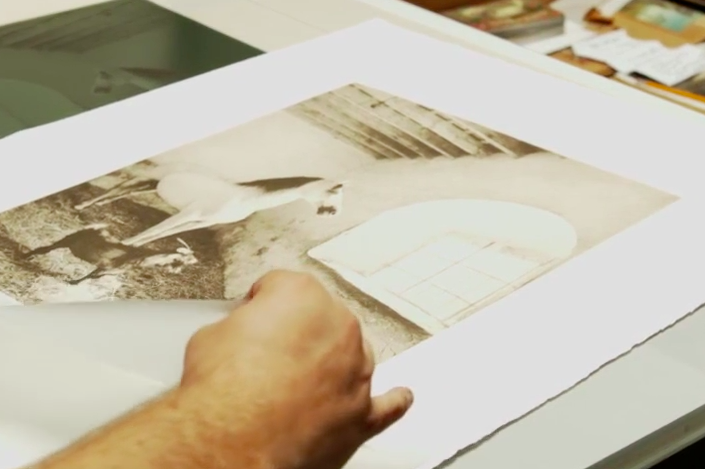
See Video Part 6: Making the Print
Watch this Video:
|
Previous Page:
|
Next Page:
|
Video Transcription Index | Watch All Printmaking Videos
|
The following is a text transcription of Part 6 of our short, 7-part video tutorial series on photogravure intaglio printmaking using Intaglio Editions polymer photogravure plates.
Making the print is the culmination of all the work leading up to making the print. There are many opportunities for mistakes, but none so disheartening as when one is made at this critical moment of creating a work on paper.
Video Transcription: Part 6 - Making the Print
Demonstration of etching ink preparation
Jon Lybrook, Intaglio Editions - March 2014
"All right, now I'm going to grab the plate that we meticulously wiped...and this is where I do a spot check, so I will look on the plate... you hold it at right angles...at the correct angle I should say...and you'll see dust particles and stuff. You can get those [ off the plate ] by using the flat part of your palm and just kind of whisk them away...that's about right. And so I will put this down...the correct orientation...I will get my paper...so I can see that my initial is in this corner, so I want to have the printable side...the printable side is facing away from me right now.
So you've got a little bit of time and a little bit of wiggle-room with the Asian paper in particular because it's so thin, you can kind of adjust where you place it. You don't want to do this with most European papers cause they're thicker and will start absorbing the ink right away.
And I'm going to recycle the backing sheet that I used to calendar the paper initially, as you recall...and I'll use this as a backing sheet. Reason you want a backing sheet is because this paper is so incredibly thin that the ink will actually transfer through the paper and will get on the blankets unless we have this backing sheet.
So now I check my blankets, make sure they're nice and smooth when I lay them down, any wrinkle can be detrimental not just to the print but also to the plate, sometimes a wrinkle in the blanket can actually transfer to the plate and cause permanent damage to it.
Periodically I'll check the pressure on the press throughout the day because as I print the blanket gets more and more compressed and that'll change the appearance of the print so we want to make sure we maintain the right amount of pressure at all the time. So that looks pretty tight, and I'll run it through.
It's a little tighter now that there's a plate underneath, and again, the important thing is to keep moving.
Okay, you want to see the unveiling?
If the paper wants to stick to the backing sheet we just let it and we'll pick the whole thing up at once [ as we allow gravity to peel the paper from the backing sheet for us ]. If it doesn't separate then I might peel them apart separately...but now it's all coming up at once.
So there is the print...I'm going to gently peel it off. It might be thin but this kozo is very very strong paper...and there we have it! This print will dry lighter, but very good for our first print.
So the more you print a plate, the better it gets, the prints just continually get better the more the plate gets seasoned, the more it prints, the more it experiences the pressure. The ink it just kind of gels and becomes more painterly the more you print [ Intaglio Editions plates] while still retaining the sharpness.
So one of the beauties of these thin Asian papers is you can have any kind of backing behind it. The color of the backing sheet will affect the look of the piece. The collector could influence the way a piece looks by choosing different toned backing. It could be warmer or cooler, and it's also just a beautiful hand-made paper.
So that print will be dry within the hour and we'll then flatten it and it will be ready for framing in about a week with colored inks, or three days with black ink.
So now this plate...if we weren't going to continue to print it, we'd have to clean it, and we do have plate-cleaning procedure online at intaglioeditions.com where we talk about how to best preserve your plate and clean it properly so that you get the maximum number of prints out of it. Since we're going to continue to print this, we'll put it back and clean the bed.
You only have to ruin a good print once to reinforce your cleanliness habits and wiping down the bed after each print.
So that's it, just to recap, we went through sanding the plate, preparing the ink, I then showed you how to brayer the ink onto the plate, we used three different tarlatans...very clean, medium clean, and very dirty tarlatan, starting with the dirtiest first...we would then wipe the edge of the plate all the way around; we then do a tissue wipe with tissue paper; a final edge wipe and palm wipe before putting the plate onto the bed and printing it finally.
I hope you found this video informative, please check back at intaglioeditions.com for more videos and other helpful tips.
|


